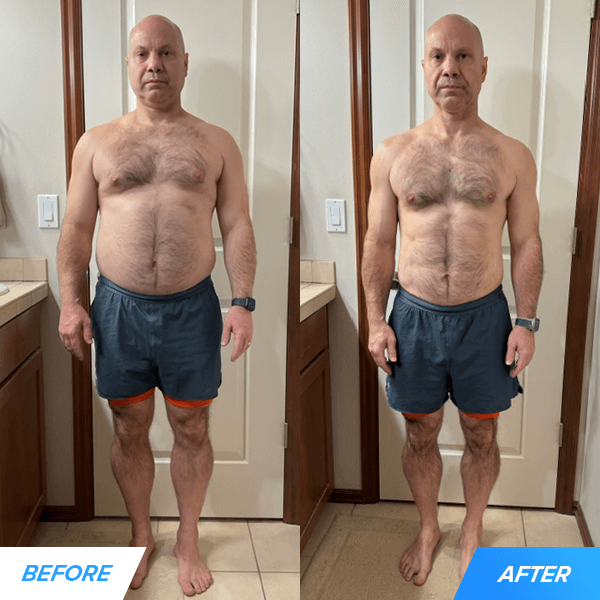The only way to lose face fat is to eat fewer calories than you burn every day. Eating a high-protein diet, exercising, and taking the right supplements can help you do this as quickly and effectively as possible.
Most guides on how to get rid of face fat are misleading.
Many claim the secret is stretching your face. Others swear by jaw exercises, facial massages, or “face slimming” tools like jaw trainers and masks. A few even suggest wearing a ”jaw bra” is the key.
None of these methods work.
But that doesn’t mean facial fat loss is impossible—you absolutely can lose fat from your cheeks, chin, and neck. You just have to do it the right way.
I can’t promise you’ll ever get a superhero jawline or superheroine cheekbones. And if you’re looking for how to lose face fat quick—in a week or a day, for instance—you’re in the wrong place.
But if you’re ready to follow the right steps and give it a few months, you can absolutely slim down your face—and this article will show you how.
Key Takeaways
- The only way to lose face fat is to lower your overall body fat by eating fewer calories than you burn.
- You can’t spot-reduce fat, so face fat will only shrink as part of overall fat loss. For some, it goes early. For others, it’s the last to disappear.
- Tools like jaw trainers, face slimming masks, or neck fat exercises won’t help. They burn too few calories to matter.
- To lose facial fat, eat in a calorie deficit, consume plenty of protein, lift heavy weights, and do some cardio.
- To accelerate your results, consider taking caffeine, yohimbine, and a fat burner.
- Most people need to lose 10-to-20 pounds of fat to notice a slimmer face—usually over the course of 2-to-3 months.
How to Lose Face Fat Quickly

To lose face fat fast, you must lower your overall body fat percentage.
And the only way to do that is to consistently eat fewer calories than you burn (more on the specifics soon). When you do this, you create a “calorie deficit,” and your body starts burning stored fat for energy—including the fat in your face, chin, and neck.
Just bear in mind that you can’t choose where you lose fat. That is, you won’t only lose face fat when you eat in a calorie deficit. For some, face fat is the first to go. For others, it’s the last to budge, only shrinking once their overall body fat is much lower.
If you fall into that latter group, don’t get discouraged—as long as you’re losing fat, your face will slim down. It just may take a little longer to show. One of Legion’s body transformation coaching clients, Stan, is a good example of this.
He followed the same strategies you’ll learn in this article and saw major changes in his body composition—but his face only started noticeably leaning out in the final stretch of his six-month cut.

The takeaway? Stick with it. The results will come.
READ MORE: Where You Will Notice Weight Loss First
Do Face Fat Exercises Work for Facial Fat Loss?
No—face fat exercises don’t accelerate facial fat loss.
Despite what many guides on reducing face and neck fat say, no amount of jaw exercises, face slimming tools, or neck fat exercises will meaningfully change how your face looks.
You can’t “spot reduce fat.” That is, you can’t target fat loss in specific areas by stretching or training the surrounding muscles.
If you’re serious about how to lose fat in your face and get rid of neck fat, focus on getting leaner overall. As your body fat percentage drops, so will the fat in your cheeks, chin, and neck.
How to Lose Face Fat in 5 Simple Steps

If you’re wondering how to lose fat in your face, these five steps will help you do it safely and effectively.
1. Create a Calorie Deficit to Lose Face Fat Fast
To lose face fat, you need to lose body fat overall—and the only way to do that is by maintaining a calorie deficit.
Research shows that eating 20-to-25% fewer calories than you burn daily is aggressive enough to promote fat loss (including from your face and neck) without causing muscle loss, excessive hunger, or fatigue.
To learn more about how many calories you should eat to lose cheek fat, check out the Legion Calorie Calculator here.
2. Eat a High-Protein Diet
High-protein dieting beats low-protein in every way, especially when you’re dieting to lose face fat (or any fat for that matter).
Aim for 0.8-to-1 gram of protein per pound of body weight daily. If you’re 25%+ body fat (men) or 30%+ (women), a simpler rule is to eat enough protein to make up around 40% of your daily calories.
3. Lift Heavy Weights
Heavy, compound weightlifting is one of the most effective ways to accelerate fat loss—and that includes face fat.
Here’s how to do it right:
- Lift 3-to-5 times per week
- Prioritize compound lifts like squats, deadlifts, presses, and rows
- Train in the 4-to-12 rep range using 75-to-85% of your 1-rep max
- Aim to add weight or reps to every exercise in every workout
READ MORE: How to Use Strength Training for Weight Loss
4. Do Some Cardio
Cardio helps you burn more calories and lose face fat faster—especially when combined with strength training.
Here’s how to do it effectively:
- Do at least two low- to moderate-intensity cardio workouts per week of 20-to-60 minutes each.
- Do one HIIT workout weekly if you enjoy it.
- Limit total cardio to 2-to-3 hours weekly.
- Do your cardio and weightlifting on separate days if possible, and if you have to do them on the same day, lift weights first and try to separate the two workouts by at least 6 hours.
5. Take Fat Loss Supplements
The best supplements to boost face fat loss are:
- Caffeine: 3-to-6 mg of caffeine per kilogram of body weight per day increases metabolic rate and helps you train harder while dieting. For a clean, delicious source of caffeine, try Legion’s pre-workout Pulse.
- Yohimbine: 0.1-to-0.2 milligrams of yohimbine per kilogram of body weight before fasted training increases fat loss and is particularly helpful with losing “stubborn” fat. Legion’s pre-workout fat burner Forge is a fantastic natural source of yohimbine.
- Fat Burner: Effective fat burners contain ingredients that boost the number of calories you burn and reduce hunger and cravings, making weight loss more straightforward. For a top-tier fat burner, try Legion’s fat burner Phoenix.
(And if you’d like to learn more about what supplements you should take to reach all your health and fitness goals, take the Legion Supplement Finder Quiz.)
How Long Does it Take to Lose Face Fat?

For most people, it takes 2-to-3 months to lose enough facial fat for it to be noticeable.
On average, a healthy rate of fat loss is 0.5-to-1% of your body weight per week, or about 1-to-2 pounds per week for most people.
Assuming you need to lose around 10-to-20 pounds of fat before your face visibly slims down—which is typical if you’re starting around 20% body fat (men) or 28% (women)—that kind of progress usually takes 8-to-12 weeks.
That might sound slow, but it’s actually a realistic timeline (most people overestimate how quickly they can lose face fat—and fat in general).
Can You Lose Face Fat in 24 Hours?
No—you can’t lose face fat in 24 hours.
Even starving yourself won’t make a visible dent in your cheek or chin fat that quickly. Most of what people mistake for “face slimming” in a day is just reduced water retention, not actual fat loss.
That said, if your face looks puffier than usual, cutting back on salty foods, drinking more water, and getting a good night’s sleep can help your face look a little leaner, at least temporarily.
Can You Lose Face Fat in a Week?
No—you can’t lose noticeable face fat in a week.
You might be able to lose 1-to-2 pounds of fat in a week if you maintain a calorie deficit—but don’t expect all of it to come from your face.
Fat loss doesn’t happen in one area at a time, so your cheeks and jawline won’t change dramatically after just seven days. What you can do in a week is start building the habits that actually lead to long-term results, such as controlling calorie intake, eating plenty of protein, and lifting weights.
Stick with those, and your face will slim down over time.
How to Lose Face Fat: FAQs
FAQ #1: Why do I have a double chin when I’m skinny?
If you’re skinny but have a double chin, it’s likely because of your genetics. That is, your genetics predispose you to storing fat in your face and neck rather than in another part of your body (your lower back, thighs, or belly, for example)
If this is the case for you, losing face fat completely can be tough—you’d have to reach a very low body fat percentage to see significant results. And that won’t suit everyone.
A better solution for most is to slim your face and neck as much as possible by reducing your body fat percentage as low as you sustainably can. Then, learn to be okay with the results. When it gets to that point, chances are you’re the only one who notices your neck fat anyway. 🙂
FAQ #2: Does chewing gum help you lose face fat?
No, chewing gum doesn’t help you lose face fat because it burns too few calories (~11 per hour) to make a significant difference to overall weight loss.
FAQ #3: Why is face fat so hard to lose?
Some people find face fat hard to lose because their genetics predispose them to storing fat around their cheeks and chin. That is, the face and neck are the first places some people store fat, and the last places fat clings to when they lose weight.
The good news is that all fat shrinks in the face of a prolonged calorie deficit. As long as you eat correctly and exercise regularly over the long term, stubborn fat will disappear—it’ll just take longer than fat in other areas.
Scientific References +
- Huovinen, Heikki T., et al. “Body Composition and Power Performance Improved after Weight Reduction in Male Athletes without Hampering Hormonal Balance.” Journal of Strength and Conditioning Research, vol. 29, no. 1, Jan. 2015, pp. 29–36, https://doi.org/10.1519/jsc.0000000000000619.
- Farinatti, Paulo TV, and Antonio G Castinheiras Neto. “The Effect of Between-Set Rest Intervals on the Oxygen Uptake during and after Resistance Exercise Sessions Performed with Large- and Small-Muscle Mass.” Journal of Strength and Conditioning Research, vol. 25, no. 11, Nov. 2011, pp. 3181–3190, https://doi.org/10.1519/jsc.0b013e318212e415.
- MARX, JAMES O., et al. “Low-Volume Circuit versus High-Volume Periodized Resistance Training in Women.” Medicine and Science in Sports and Exercise, Apr. 2001, pp. 635–643, https://doi.org/10.1097/00005768-200104000-00019.
- Yarizadeh, Habib, et al. “The Effect of Aerobic and Resistance Training and Combined Exercise Modalities on Subcutaneous Abdominal Fat: A Systematic Review and Meta-Analysis of Randomized Clinical Trials.” Advances in Nutrition, vol. 12, no. 1, 17 Aug. 2020, https://doi.org/10.1093/advances/nmaa090.
- Astrup, A, et al. “Caffeine: A Double-Blind, Placebo-Controlled Study of Its Thermogenic, Metabolic, and Cardiovascular Effects in Healthy Volunteers.” The American Journal of Clinical Nutrition, vol. 51, no. 5, 1 May 1990, pp. 759–767, https://doi.org/10.1093/ajcn/51.5.759.
- Astorino, Todd A., et al. “Effect of Caffeine Ingestion on One-Repetition Maximum Muscular Strength.” European Journal of Applied Physiology, vol. 102, no. 2, 13 Sept. 2007, pp. 127–132, https://doi.org/10.1007/s00421-007-0557-x.
- Tw, Beck, et al. “The Acute Effects of a Caffeine-Containing Supplement on Strength, Muscular Endurance, and Anaerobic Capabilities.” Journal of Strength and Conditioning Research, 1 Aug. 2006, pubmed.ncbi.nlm.nih.gov/16937961/.
- Ostojic, Sergej M. “Yohimbine: The Effects on Body Composition and Exercise Performance in Soccer Players.” Research in Sports Medicine, vol. 14, no. 4, Dec. 2006, pp. 289–299, https://doi.org/10.1080/15438620600987106.
- Mark, Millan, et al. Agonist and Antagonist Actions of Yohimbine as Compared to Fluparoxan at ?2-Adrenergic Receptors (AR)S, Serotonin (5-HT)1A, 5-HT1B, 5-HT1D and Dopamine D2 and D3 Receptors. Significance for the Modulation of Frontocortical Monoaminergic Transmission and Depressive States. Vol. 35, no. 2, 1 Feb. 2000, pp. 79–95, https://doi.org/10.1002/(sici)1098-2396(200002)35:2%3C79::aid-syn1%3E3.0.co;2-x.
- Helms, Eric R, et al. “Evidence-Based Recommendations for Natural Bodybuilding Contest Preparation: Nutrition and Supplementation.” Journal of the International Society of Sports Nutrition, vol. 11, no. 1, 12 May 2014, https://doi.org/10.1186/1550-2783-11-20.
- Levine, James A, et al. The Energy Expended in Chewing Gum. Vol. 341, no. 27, 30 Dec. 1999, pp. 2100–2100, https://doi.org/10.1056/nejm199912303412718. Accessed 4 June 2023.










